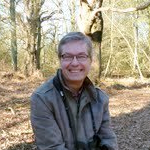 Wood Green Mennonite Church, London, is piloting a 'walking' fresh expression this year. Phil Wood, a member of Wood Green, explains how the monthly church is a mixture of walking, talking, prayer, liturgy and meditation.
Wood Green Mennonite Church, London, is piloting a 'walking' fresh expression this year. Phil Wood, a member of Wood Green, explains how the monthly church is a mixture of walking, talking, prayer, liturgy and meditation.
Walking has always been a passion of mine – whether hiking, rambling, bird-watching or prayer-walking. I first came across Rebecca Seaton and a Methodist South Lakes 'Walking Church' experiment in Cumbria. Their 'boots on the ground' approach proved something of an inspiration.
It has taken a few years and a move to London for the idea to become reality. There has been much to consider. For a start, we've had to take a fairly close look at what we understand by the term 'Walking Church'. There are plenty of organisations for Christian walkers and many churches have walking groups but we are not looking at an ecumenical 'fellowship' made up of Christians who walk in their spare time but a church that walks! Imagine a congregation where the essential elements of church – mission, sacraments, worship and the Word – primarily take place on the move or in the context of hospitality along the way. The idea is to create a community of faith where the heartlands of 'church' happen in the course of walking.
 When I first talked of this, responses were mixed. No matter how practised I become at explaining the notion of a congregation where church occurs in the walking there are still people who don't 'get it'. That isn't surprising. Walking Church was never intended to be in competition with worship inside a traditional church building – some still think it is a gimmick but I believe they are wrong.
When I first talked of this, responses were mixed. No matter how practised I become at explaining the notion of a congregation where church occurs in the walking there are still people who don't 'get it'. That isn't surprising. Walking Church was never intended to be in competition with worship inside a traditional church building – some still think it is a gimmick but I believe they are wrong.
But my congregation at Wood Green Mennonite Church caught the vision and, following an Epping Forest taster last autumn, we pulled on our backpacks for a full-blown 2012 pilot. We're walking four London locations this year with walks arranged for the final Sunday morning of the month, changing location every quarter.
Every walk has a leader responsible for a theme and three or four reflections. We walk, eat, listen, meditate, pray and sometimes sing – though the latter is a topic of discussion. It also involves hospitality – whether in homes, pubs or cafes. Each time we learn a little more. Much of our missional energy is focused before the day of the walk because it needs a good deal of preparation with routes needing to be surveyed, publicity disseminated and conversations had.
We have just completed our Highgate series of walks. In February, I joined others on a walk between Highgate and Alexandra Palace. Wayne Hostetler led it on the theme of 'perspective' and there were some splendid views of north London to illustrate the point. We talked about the panorama from Alexandra Palace with the City skyscrapers to inner-city Tottenham and the 'smudge' of Epping Forest – all that poverty and power cheek by jowl.

Since then, we have also tackled the 4.5 miles Parkland Walk in London's largest nature reserve following the old railway line from Finsbury Park to Alexandra Palace. Now Walking Church is preparing to travel south of the river to Richmond for walks in April, May and June. Our first is scheduled to take place on Sunday (29th April) in Richmond Park with the aim of covering 2.5 to 3 miles in about three hours.
Where do we go next with this idea? There are multiple possibilities but we are trying to get our priorities right and inclusiveness is a challenge. How do we accommodate 'serious' ramblers, not-so-serious amblers, exponents of 'walking meditation' and pilgrimage and those walking for health and ecological awareness? Also, how do we go about youth and children's work and what provision are we making for those with limited mobility?
I see Walking Churches as having enormous mission potential. According to the Mission-shaped Church report, 20% of the UK population is involved in walking as a leisure activity – a figure just slightly lower than that of the entire British churchgoing constituency. There are 139,000 members in the Ramblers (formerly the Ramblers Association) alone. In large areas of Britain there are more people out walking on a Sunday than going to worship.

Of course, there are a number of potential pitfalls for Walking Church – with one of the most obvious being the weather! Although the main activity would obviously be walking there is clearly a need for some time indoors as well as outdoors – as long as this doesn't undermine the nature of the church.
Hospitality is the bridge to providing this support, especially where a Walking Church is linked to an existing congregation. What a wonderful way not only to cope with the weather but also to nurture a profound link between walking and welcome, between continuing and emerging churches. However, there's nothing to say that hospitality needs to be in a church building; it could be in a pub, a home, a youth hostel or any number of other locations. Walking Church also raises the possibility of linking together fresh expressions of church – for example by partnering with a café church.
Some provision has to be made for the practicalities of teaching, worshipping and sharing the Good News on the move but otherwise the business of 'church' remains much the same. A church that walks still needs leadership, administration, health and safety and safeguarding, for example. We would also need to bear in mind the optimum size of a walking church given the practical limitations of audible conversation and the challenges of arranging hospitality for considerable numbers of people.

In terms of organisation, I believe the cell church model – with some adaptation – offers the best insights for structuring walking churches. The largest investment in walking church from the outset is not finance; it's time – although salary, training and staff accommodation costs should also be considered.
I have been thinking too as what might be possible as Walking Church develops. Here are some of the early thoughts:
- a link with a Tourist Information Centre;
- versatility of Walking Church – urban, rural or suburban;
- launching Walking Church via a long distance path such as the Pennine Way or the Ridgeway, perhaps involving people from different churches along the route;
- there is a strong ecological dimension – opportunities for awareness raising and practical conservation;
- walking with a webcam would enable a Walking Church 'service' (a walk) to be viewed live online. Potential to link congregations in different areas or across denominations;
- offers a natural window into powerful expressions of social justice in identification with the stranger, the homeless and the refugee;
- walking Church 'guidebooks' could be an exercise both in devotional and travel writing;
- play a significant role in extremely rural communities;
- could walk 'home or away' (i.e. near or far away from where most members live) or it might draw members from a wide area based on a network connection. So, a Walking Church might have a close association with one locality or much more of a network focus.
 We're learning something about evangelism in the values driving this particular fresh expression. One of our walkers likes us because we don't 'proselytise', instead we 'reflect'. Are we too peaceable to share faith? I hope not – but our message isn't 'become like us and you will be saved'. We are a 'peace church'. Yes, words are important, but mostly peace is in the pace. It's easier to listen at three miles per hour.
We're learning something about evangelism in the values driving this particular fresh expression. One of our walkers likes us because we don't 'proselytise', instead we 'reflect'. Are we too peaceable to share faith? I hope not – but our message isn't 'become like us and you will be saved'. We are a 'peace church'. Yes, words are important, but mostly peace is in the pace. It's easier to listen at three miles per hour.
 Phil Wood discusses church with boots on.
Phil Wood discusses church with boots on.


 Mennonites – Amish first cousins, plain dressing, peaceable types? Well, yes that's the conservative wing of the Tradition but – in practice – Mennonites come in all shapes and sizes. Our Wood Green Mennonite Church is a little left of centre. Not a buggy in sight!
Mennonites – Amish first cousins, plain dressing, peaceable types? Well, yes that's the conservative wing of the Tradition but – in practice – Mennonites come in all shapes and sizes. Our Wood Green Mennonite Church is a little left of centre. Not a buggy in sight!
 Wood Green Mennonite Church, London, is piloting a 'walking' fresh expression this year. Phil Wood, a member of Wood Green, explains how the monthly church is a mixture of walking, talking, prayer, liturgy and meditation.
Wood Green Mennonite Church, London, is piloting a 'walking' fresh expression this year. Phil Wood, a member of Wood Green, explains how the monthly church is a mixture of walking, talking, prayer, liturgy and meditation. When I first talked of this, responses were mixed. No matter how practised I become at explaining the notion of a congregation where church occurs in the walking there are still people who don't 'get it'. That isn't surprising. Walking Church was never intended to be in competition with worship inside a traditional church building – some still think it is a gimmick but I believe they are wrong.
When I first talked of this, responses were mixed. No matter how practised I become at explaining the notion of a congregation where church occurs in the walking there are still people who don't 'get it'. That isn't surprising. Walking Church was never intended to be in competition with worship inside a traditional church building – some still think it is a gimmick but I believe they are wrong.


 We're learning something about evangelism in the values driving this particular fresh expression. One of our walkers likes us because we don't 'proselytise', instead we 'reflect'. Are we too peaceable to share faith? I hope not – but our message isn't 'become like us and you will be saved'. We are a 'peace church'. Yes, words are important, but mostly peace is in the pace. It's easier to listen at three miles per hour.
We're learning something about evangelism in the values driving this particular fresh expression. One of our walkers likes us because we don't 'proselytise', instead we 'reflect'. Are we too peaceable to share faith? I hope not – but our message isn't 'become like us and you will be saved'. We are a 'peace church'. Yes, words are important, but mostly peace is in the pace. It's easier to listen at three miles per hour.